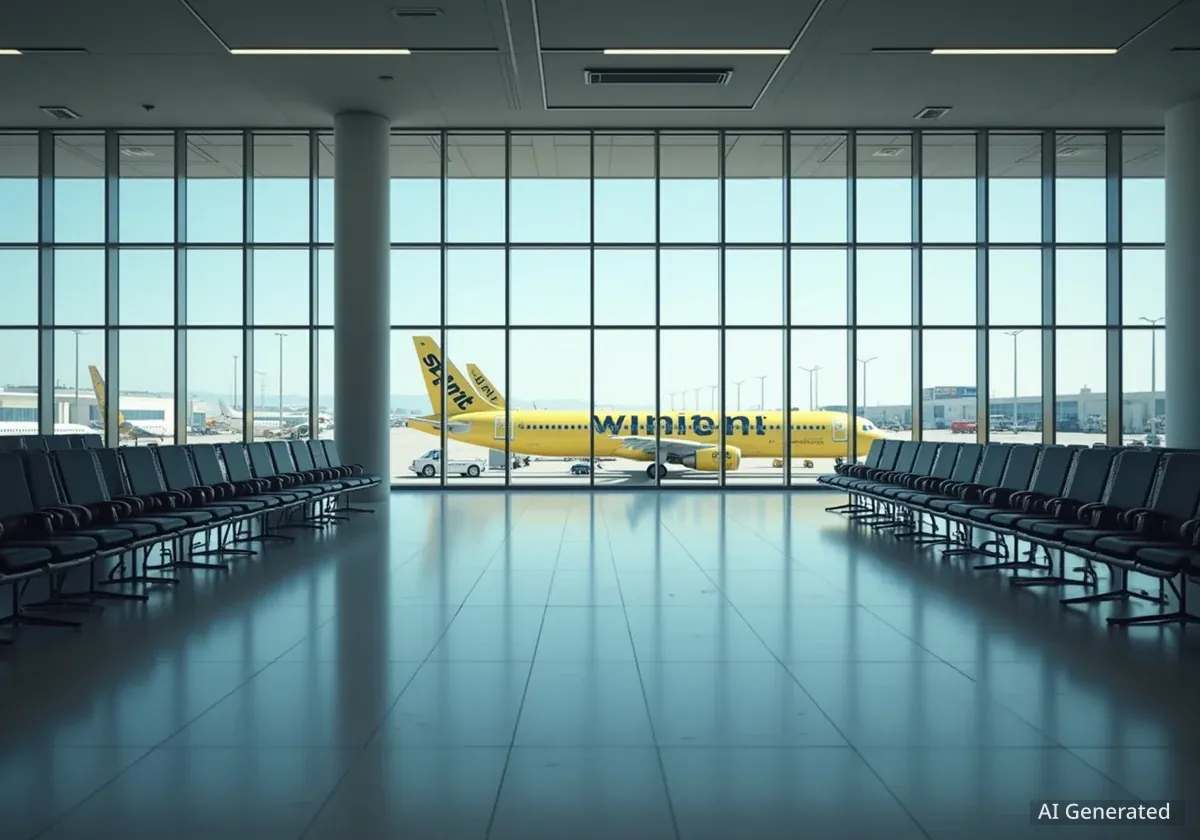Spirit Airlines is actively engaged in discussions regarding a potential merger or takeover, as the carrier navigates its second Chapter 11 reorganization in less than a year. The Florida-based airline, known for its ultra-low-cost model, faces significant financial challenges and is outlining a detailed plan for future operations, whether as an independent entity or part of a larger company.
Key Takeaways
- Spirit Airlines is discussing merger or takeover options with multiple interested parties.
- The airline plans significant schedule cuts, reducing its size by 20% in 2026.
- Spirit will streamline its fleet, removing new-technology Airbus A320neo and A321neo planes.
- The carrier intends to reposition its brand to target a more 'value-seeking audience'.
- Cost reduction remains a central focus, including pilot and flight attendant furloughs.
Merger Talks and Financial Pressures
Spirit Airlines has confirmed it is in active discussions with several interested parties concerning a potential merger or sale. This development comes as the airline grapples with financial difficulties, having filed for Chapter 11 reorganization in August, its second such filing in under a year. The airline has struggled to increase revenues faster than its operating costs since the COVID-19 pandemic, leading to consistent financial losses.
The possibility of a merger or asset sale has been widely considered as a primary solution for Spirit. Industry analysts suggest that competitors like Frontier Airlines and JetBlue Airways would benefit most from Spirit's potential disappearance from the market. Other carriers, including Southwest Airlines, would also likely see gains. Spirit has previously attempted mergers with both Frontier and JetBlue since 2022, though these efforts did not succeed.
Spirit's Financial Struggles
- Filed for second Chapter 11 reorganization in August.
- Struggled to grow revenues faster than costs since the pandemic.
- Previous merger attempts with Frontier and JetBlue failed.
Future Plans if Spirit Remains Independent
Beyond merger talks, Spirit has also detailed its strategic plan should it emerge from bankruptcy as an independent airline. This plan includes significant operational changes aimed at stabilizing its financial position and improving its market standing.
Scheduled Capacity Reductions
A major component of Spirit's independent plan involves substantial schedule cuts. The airline projects it will be approximately 20% smaller in 2026 compared to its current size. These reductions are in addition to cuts already implemented; aviation analytics firm Cirium data shows Spirit's seat capacity is forecast to drop by 24% in 2025. The carrier hopes to resume "modest growth" in 2027, with an average annual growth rate of around 9% thereafter.
"Many people have experienced [ultra-low-cost carrier] service and know what it means versus the full-service carrier," stated Ahmed Abdelghany, an associate dean and professor at Embry-Riddle Aeronautical University, commenting on shifts in traveler preference.
Fleet Modernization and Reliability
Spirit plans to streamline its fleet, focusing exclusively on reliable Airbus A320 and A321 aircraft. This strategy means phasing out its new-technology A320neo and A321neo planes, which have been plagued by issues with their Pratt & Whitney engines. In September, 38 A320neo-family planes were grounded due to engine problems, with another 20 aircraft parked ahead of sale. Spirit has already sought court approval to return over 100 of its 214 planes to lessors.
Engine Troubles
Pratt & Whitney engine issues have impacted several airlines operating A320neo-family aircraft. These problems often lead to groundings for inspections or repairs, disrupting flight schedules and increasing operational costs for carriers.
Brand Repositioning and Market Shift
Perhaps the most ambitious aspect of Spirit's stand-alone strategy is its intention to reposition its brand. The airline aims to shift its image from a bare-bones, no-frills carrier to one that caters to a "value-seeking audience." This move seeks to attract customers who prioritize affordability but also expect a reasonable level of service. Spirit has already upgraded its 'Big Front Seat' to a 'business class' offering and installed extra-legroom premium economy seats, reflecting a broader industry trend towards cabin premiumization.
This brand shift presents a significant challenge for Spirit, given its historical reputation as an unpopular but highly affordable travel option. Market dynamics have changed since the late 2010s, when ultra-low-cost carriers like Spirit experienced rapid growth. Travelers today may be more discerning, as observed by Professor Abdelghany, who noted a shift in preferences towards full-service carriers like Delta Air Lines and United Airlines.
Cost-Cutting Initiatives
Underpinning all of Spirit's plans is a strong commitment to reducing costs, which have escalated rapidly since the pandemic. In addition to shrinking its fleet, the airline has issued furlough notices to hundreds of pilots and flight attendants. It has also removed more than a dozen unprofitable destinations from its route map, focusing on more financially viable routes to improve operational efficiency.
- Furloughs: Hundreds of pilots and flight attendants notified.
- Route Cuts: Over a dozen unprofitable destinations removed.
- Fleet Reduction: Streamlining to reliable Airbus A320/A321 models.
These measures are designed to bring Spirit's cost structure back into alignment, allowing it to compete more effectively in a challenging airline market. The outcome of its merger discussions and the success of its independent restructuring plan will determine the future trajectory for the budget carrier.





